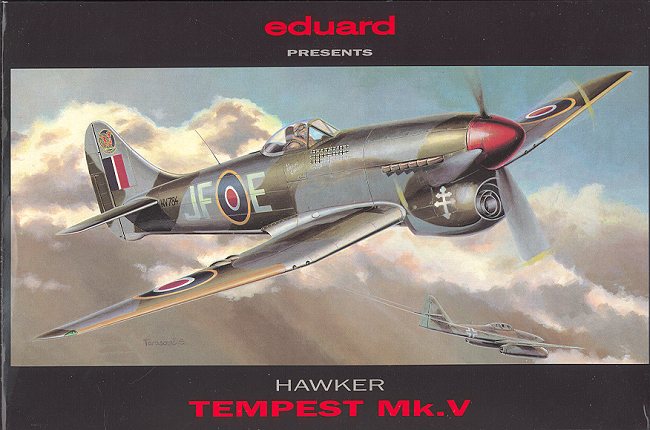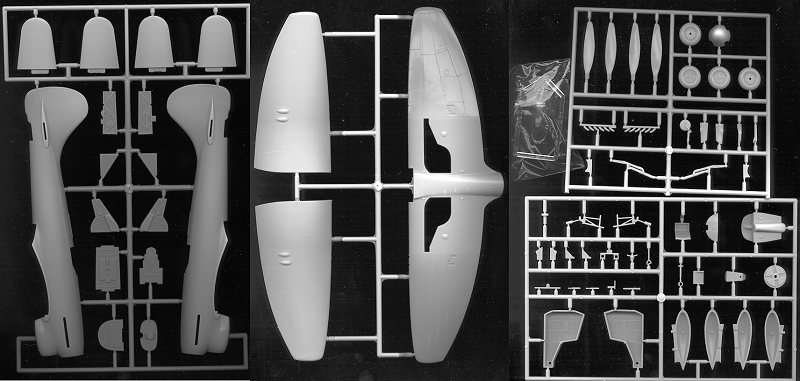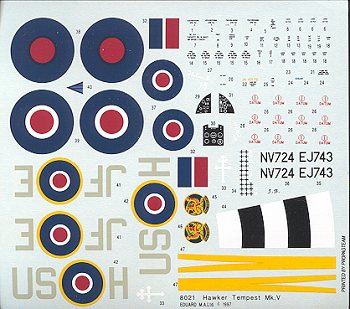
|
KIT: |
Eduard 1/48 Tempest V |
|
KIT # |
8021 |
|
PRICE: |
$24.95 |
|
DECALS: |
Two aircraft |
|
REVIEW & |
|
|
NOTES: |
|

|
HISTORY |
The time is 1941. The people of the UK are no longer worried about having to learn German. Britain has developed a fighter called the Typhoon. It has proven to have a rather fussy engine and isn't exactly the fastest thing around. Despite being a bust as an interceptor, it proved to be a rather good fighter bomber. Though it has continuing teething problems with its Sabre I engine, the RAF put out a request for an improved version of the Typhoon. This was to eventually become the Tempest, one of the finest British fighters of the war.
Hedging their bets in the engine department, Tempests were built with Griffon, Centarus and Sabre engines. The Griffon engined version wasn't proceeded with past a few prototypes and the Centarus version wasn't operational until after the war. It was the Sabre II powered Tempest that saw all the action. The Tempest was based very much on the Typhoon and there is a striking family resemblance. Where the Tempest is so much better is due to the airfoil section of the wing and tailplanes. Using a laminar flow wing along with lengthening the fuselage made into a much faster and more stable aircraft. A dorsal fin fillet was also added to improve handling.
Tempests first entered service in mid-1944. They were as accomplished at ground attack as the Typhoons and were used as such during the Normandy invasion. Where they really came into their own was in killing doodle bugs (V-1s). Since the Tempest was the fastest fighter available, it was natural that they would be used for this purpose. Over a third of the 1,771 V-1s knocked down during the war were done with Tempests. The Tempest was also pretty good at bagging Me-262s, with 20 to their credit by the end of the war.
|
THE KIT |

Eduard is one of those nice success stories in the modeling world. They first started out doing the standard limited run injected kit. One that took quite a bit of work. Steadily, they have improved. The Tempest is one of the more recent issues and is just that much closer to mainstream injected kits. The sprue gates are small, the parts are well molded and the detailing is good and consistent. There are still large ejector pins on many of the larger parts that will have to be removed, but the kit is engineered so that these stumps of plastic are not in the middle of any detail.
The kit is well equipped with a full interior as well as a nice wheel well insert to give you a full and deep wheel well. The cockpit instruments are given as decals, though the panel itself has some detail on it. There is but one transparency and that is the canopy. It is molded in the closed position and a bit thick so no need to go nuts in the interior as you won't be able to see much of it through the closed canopy. The only options are for two underwing fuel tanks.
 The
instruction sheet is all one expects from a modern sheet and contains seven
construction steps. Color callouts are given in each step as appropriate. The
color chart only gives generic color references, but does list the part numbers
of several different paint companies.
The
instruction sheet is all one expects from a modern sheet and contains seven
construction steps. Color callouts are given in each step as appropriate. The
color chart only gives generic color references, but does list the part numbers
of several different paint companies.
The decal sheet for this kit is really quite impressive. It is made by Propagteam, so you know it is of extreme thinness and excellent registration and color quality. There is a full suite of stencils in addition to the markings for two aircraft. I cannot think of a Tempest kit that doesn't include markings for JF*E, Pierre Clostermann's Tempest V, and this one is no exception. I'll leave it to the experts to argue over the number of kills and the color of the code letters, but it looks good to me. The other aircraft is from 56 Sq at Volkel in the Netherlands in late 1944. This one has remnants of D-Day striping under the fuselage. The yellow ID strip on the wing leading edge is given as a decal, but I'd paint mine on if I were you.
Overall, it looks like a very nice kit and one that should not be a problem to construct, once you remove all the ejector pins from the parts.
|
REFERENCES |
Aircraft of the Royal Air Force by Owen Thetford, 1979, Seventh Edition.
Review kit courtesy of me and my wallet!
If you would like your product reviewed fairly and quickly by a site that has over 1,100 visits a day, please contact me or see other details in the Note to Contributors.